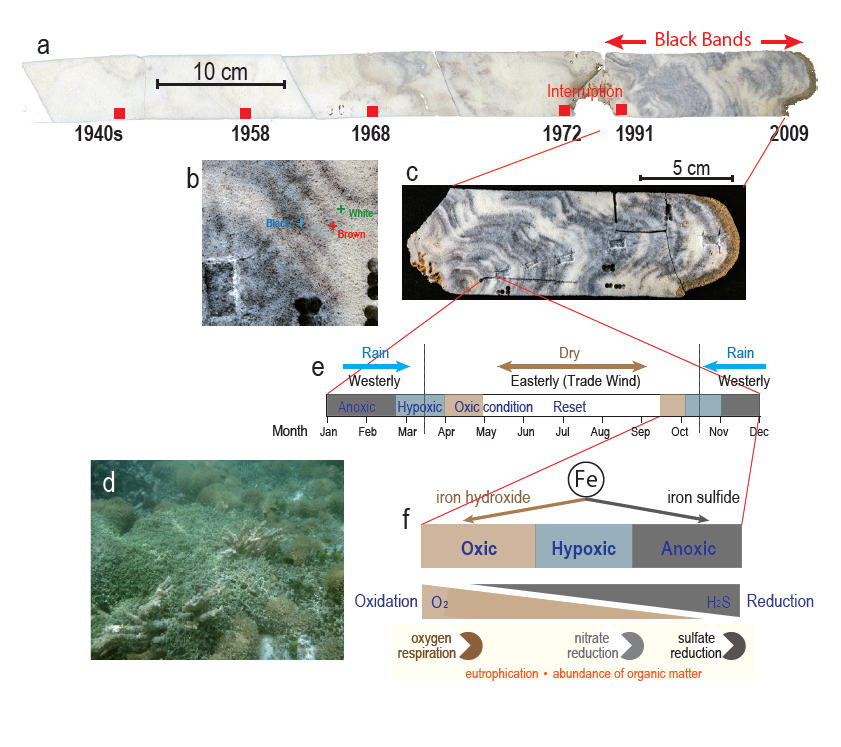Strengthening Cooperation for Peace and Sustainable Development in the Arctic Region
Sasakawa Peace Foundation Signs Memorandum of Cooperation with Greenland Government

(a) A massive Porites coral core from Fongafale Island. After not growing from 1972-1991, the coral started growing again and was contaminated with yearly black bands. (b, c) Enlargement of black bands. Photos by Nobuko Nakamura.
(d) Dead branching corals in the Fongafale lagoon. Photo by Hajime Kayanne. (e) Researchers can estimate the season of black bands based on the stable isotopic oxygen color within coral growth layers. Black bands correspond to the November-March rainy season, which brings westerly winds that lead to lower oxygen levels. (f) Schematic of the variations in color caused by iron interacting with different levels of oxygen and sulfur.
The research team determined that the variations in the colored bands were created by other elements interacting with iron. Iron is black in conditions without oxygen, but rusts, or oxidizes, to become reddish when oxygen levels rise. Bacteria that use sulfur to grow without oxygen leave behind their DNA in the coral skeleton, as well as crystals of pyrite, a mineral formed by combining iron and sulfide.
Researchers state that the black bands record the human impact on Tuvalu’s coral reef ecosystem since the 1990s. Domestic waste running into the oceans increases the amount of nutrients in the water, which then leads to out-of-control growth of algae. Sudden blooms of algae decrease the oxygen levels in the water.
"Healthy coral ecosystems play a pivotal role in island resilience against sea level rise. The ecosystem shift from coral to algal overgrowth due to pollution greatly reduces the potential of island formation. The restoration of healthy coral reef ecosystems is strongly recommended for increasing island resilience against sea level rise," said Professor Hajime Kayanne from the UTokyo Graduate School of Science, a co-author of the research publication.
Collaborators at the Univ. of Tokyo and Dentsu Inc. in Tokyo, and the National Institute for Environmental Studies in Tsukuba contributed to this research.
Papers:
Nobuko Nakamura, Hajime Kayanne, Yoshio Takahashi, Michinari Sunamura, Go Hosoi, and Hiroya Yamano, "Anthropogenic Anoxic History of the Tuvalu Atoll Recorded as Annual Black Bands in Coral," Scientific Reports: April 30, 2020, doi:10.1038/s41598-020-63578-4.
Link (Publication)
Related Links:
Nakamura, N., BEHIND THE PAPER, Anthropogenic Anoxic Black Bands in Tuvalu Coral, Nature Ecology & Evolution Community
(2020.5.1)
Univ. of Tokyo, Coral skeletons record history of reef deterioration, Black bands in coral contain iron sulfide and bacteria, UTokyo FOCUS Article
(2020.6.5)
Please direct all i